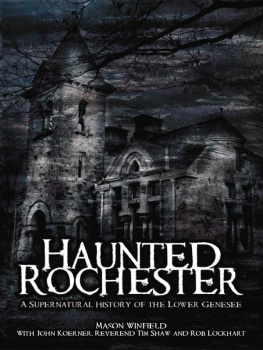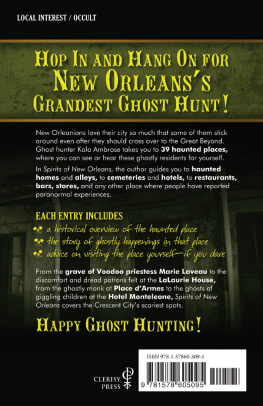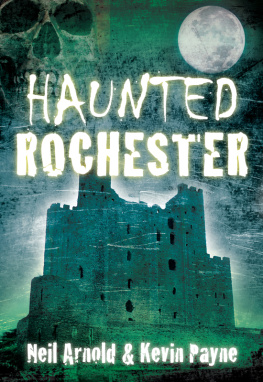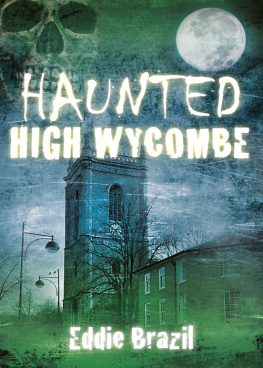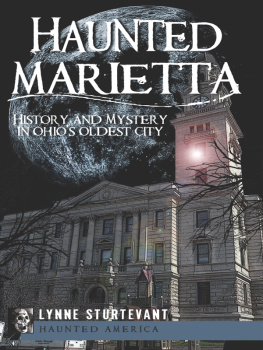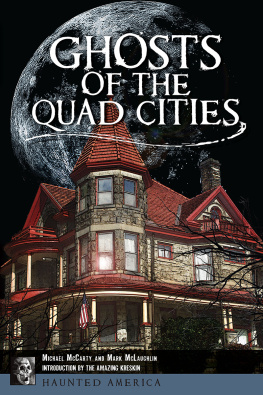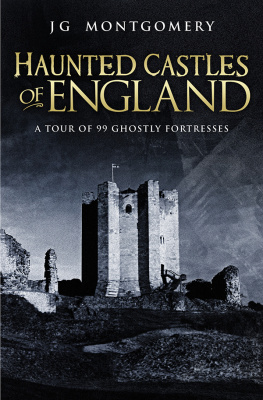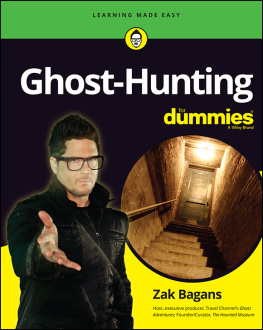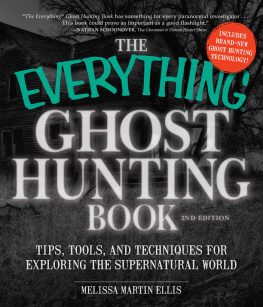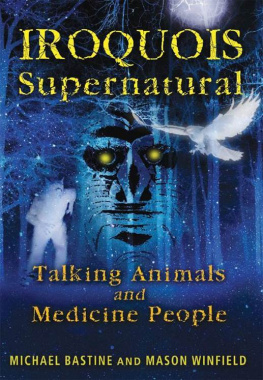

Haunted History Ghost Walks Inc.

Published by Haunted America
A Division of The History Press
Charleston, SC 29403
www.historypress.net
Copyright 2008 by Mason Winfield
All rights reserved
All images are courtesy of Mason Winfield and Amy Reed.
First published 2008
Second printing 2009; Third printing 2009; Fourth printing 2011; Fifth printing 2012; Sixth printing 2012
e-book edition 2013
ISBN 978.1.62584.364.7
Library of Congress Cataloging-in-Publication Data
Haunted Rochester : the supernatural history of the Lower Genesee / Mason Winfield [et al.].
p. cm.
print edition ISBN 978-1-59629-418-9
1. Ghosts--New York (State)--Rochester. 2. Haunted places--New York (State)--Rochester. I. Winfield, Mason.
BF1472.U6H384 2008
133.10974789--dc22
2008013312
Notice: The information in this book is true and complete to the best of our knowledge. It is offered without guarantee on the part of the author or The History Press. The author and The History Press disclaim all liability in connection with the use of this book.
All rights reserved. No part of this book may be reproduced or transmitted in any form whatsoever without prior written permission from the publisher except in the case of brief quotations embodied in critical articles and reviews.
CONTENTS
PREFACE
We did not make up anything in this book, so someone else deserves credit for everything it holds. When dealing with a nonacademic subject like ghosts, a complete listing of literary sources and inspirations would be both exhaustive and pretentious. We will mention only the most prominent. A listing of the individuals we interviewed would be outright unfair to those who talked to us confidentially.
A heavy portion of the material in the first three chapters of this book can be found somewhere in the research books of Mason Winfield: Shadows of the Western Door (1997), Spirits of the Great Hill (2001), Haunted Places of Western New York (2003) and Village Ghosts of Western New York (2006), all published by the Buffalo-based company Western New York Wares. Readers hoping for a broader look at regional hauntings are encouraged to turn to them and their listed sources.
Most of our non-paranormal information about sites and events comes from city, county and regional histories and a variety of websites on Rochesters history, culture and architecture. One that stands out is that of the Rochester-based Landmark Society of Western New York.
Our Native American insights come largely from the reflections of the missionaries nicknamed the Jesuit Relations, Bishop Seavers Autobiography of Mary Jemison, unpublished material of Mason Winfield, interviews with the late J. Sheldon Fisher and decades of conversations with any local Native American folk who would talk to us. Those on the record include the Algonkian teacher Michael Bastine, Seneca wise woman Jean Taradena and Masons late friends, the Seneca storyteller DuWayne Duce Bowen and the Tuscarora author and medicine man Ted Williams.
A half century of articles in the Rochester Democrat and Chronicle have to be credited generally, as well as Valley of the Ghosts, Shirley Cox Husteds 1982 gathering of Genesee Valley tradition. Both sources could be credited fifty times in this book. Frederick Stonehouses collections of Great Lakes lore and the books of Hudson Valley author David Pitkin contributed leads and nuggets to many of our articles, as did national paranormal surveys by Janet and Colin Bord, Mary Ellen Guiley, Dennis William Hauck and Salvatore Michael Trento.
Our fourth chapter would not have been complete without the unique insights and connections of John Koerner. Most of the work of the last two chapters was the original research and perseverance of Rob Lockhart and Reverend Tim Shaw. They identified sites, obtained research material and interviewed individuals.
Finally, our literary forefathers in upstate history and prodigy, Carl Carmer and Arch Merrill, have to be paid tribute. The sense of tradition they gave made the area seem venerable even when it was young. They did a lot to make the valley see itself as it deserves to be seen.
INTRODUCTION
YOUNG LION OF THE WEST
Old Ebenezer Allan, he
Harnessed the raging Genesee,
And hitched it to a big grist mill
Before our city was a ville.
Thomas Thackeray Swinburne
This is a book about psychic traditions, incidents and folklore in the lower Genesee Valley around Rochester, including those spontaneous apparitions we call ghosts. Psychic folklore is everywhere, of course, but this part of the upstate has been proverbial for occultism and spirit talking since the whites arrived.
The lower Genesee is at the core of the Burned-over District, and the nineteenth-century flowering of its many cults, creeds and communities was one of the more remarkable developments in United States social history. A distinguishing feature of these young religionsamong which were the Church of Mormon and Spiritualismwas their use of practices upon which the mainstream cast a cold eye: crystals, geomancy and spirit talking. Otherwise, the psychic bedrock of the valley has to be thought of as Seneca, in whose culture there was no shortage of supernaturalism. A little grounding in general history may serve us well.
The landscape is young in this part of the Great Lakes, only fifteen thousand or so years old. The glaciers, as they advanced, etched and retreated, created most of the lakes, hills and valleys that mark the region. By about 8000 BC, the climate was hospitable enough for people to settle here for good.
The north-flowing Genesee River bolts through the heart of the Onondaga Escarpment, the flinty bread loaf running through the Iroquois homeland. The stone not only makes a great projectile point, but it is also easily mined in many parts of Western New York, influencing (with water routes) the regions human prehistory.
As far as anyone knows, the first people in these parts were Paleo-Indiansthe earliest Native Americanswho might have included the ancestors of todays Eskimos. Ancient Native American societies, influenced by mound-building cultures, dominated the region by 2000 BC, and in the European Middle Ages, communities of Algonkians were here. There are tantalizing suggestions of other visitors and immigrants to this part of the valley, including Scandinavian Vikings and mystery societies no one recognizes.
By the time the Europeans were exploring the Great Lakes, the Genesee (Beautiful River) Valley was settled by the Senecas. Many of todays towns are on the sites of the culture centers of the Nundawaono (Great Hill Folk), as they called themselves. Their paths have become many of our roads, particularly ones with numbers: Routes 5, 96 and 104. Rochester sits atop their old villages.
The first known white man to see the mouth of the Genesee River was Etienne Brule, a French outdoorsman sent by Samuel de Champlain to survey the Great Lakes in 1610. The map Brule drew seems to show Irondequoit Bay and the Genesee River. The next visitors might have been Jesuit missionaries in 1635 and French explorer Ren-Robert de La Salle in 1669.
For a region so far from the coast, greater Rochester has a lot of colonial-era sites. By 1679, the first Euro-style church was raised near Irondequoit Bay on the spot of todays Our Lady of Mercy High School. In 1687, the French built a short-lived fort nearby. In 1716 and 1721, the French and English built, respectively, Fort DeSables by todays Sea Breeze and Fort Schuyler at Indian Landing.
Next page
